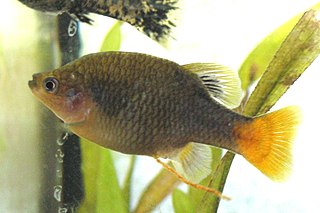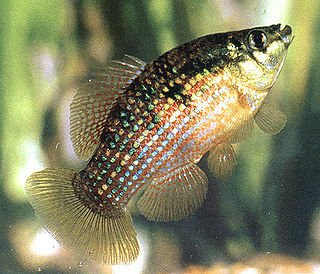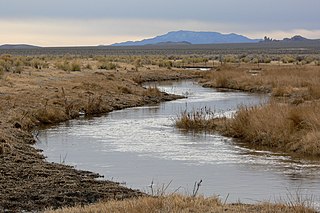
Goodeidae is a family of teleost fish endemic to Mexico and some areas of the United States. Many species are known as splitfins. This family contains about 50 species within 18 genera. The family is named after ichthyologist George Brown Goode (1851-1896).

The flagfish, also known as the American flagfish or Florida flagfish, is a species of pupfish, a type of killifish from the family Cyprinodontidae which is endemic to Florida. It is found in the aquarium trade. Its common name derives from the dominant males' body pattern, which bears some resemblance to the Flag of the United States.

The White River is a small and discontinuous 138-mile-long (222 km) river located in southeastern Nevada notable for several endemic species of fish. The river was named for F. A. White, a 19th-century explorer.

The Ash Meadows killifish is a species of killifish from the subfamily Empetrichthyinae, part of the family Goodeidae, which was first documented by C. H. Gilbert in 1893 and historically occupied numerous springs near Ash Meadows, Nye County, Nevada, United States. This species was last seen in 1948 and is believed to have gone extinct in the early 1950s, likely as a result of habitat alteration and competition with and predation by introduced crayfish Procambarus clarkii, mosquitofish, black mollies, and bullfrogs.

Crenichthys is a genus of fish in the subfamily Empetrichthyinae which is part of the family Goodeidae, the splitfins. This small genus consists of two species which are both endemic to Nevada in the United States. They occur in small populations in isolated warm springs. Fish of this genus are known commonly as springfish.
The Railroad Valley springfish, Crenichthys nevadae, is a rare goodeid fish of the Great Basin of western United States, occurring naturally in just seven thermal springs of Railroad Valley in Nye County, Nevada.
Potosi pupfish is a species of fish in the family Cyprinodontidae. It is endemic to Mexico, but is now extinct in the wild, only surviving in captivity.
The Cachorrito de la Trinidad, also known in English as the Charco Azul pupfish, was a small species of fish in the family Cyprinodontidae. It was endemic to Ojo de Agua la Presa in southwestern Nuevo Leon state in Mexico, but became extinct in 1985 due to habitat loss. The same freshwater spring system was the home of three other pupfish: Cyprinodon ceciliae (extinct), Cyprinodon longidorsalis and Cyprinodon veronicae. Although these were from the same spring system, each was restricted to its own individual spring pool. The spring pond inhabited by the Charco Azul pupfish was also the home of a now-extinct, undescribed species of Cambarellus crayfish. The specific name inmemoriam means "in memory" and signifies the extinction of the species due to its native spring being dried out by groundwater extraction soon after the discovery of this fish in 1983.
The Mezquital pupfish is a species of pupfish in the family Cyprinodontidae. It is endemic to Durango in Mexico. This species was described by Robert Rush Miller in 1976 from a pond which was fed by hot springs within the basin of the Río del Tunal, approximately 9 kilometres (5.6 mi) east of Durango City at an altitude of about 1,880 metres (6,170 ft). The specific name honors the American ichthyologist Seth Eugene Meek (1859-1914), a pioneer of the study of the freshwater fish of Mexico.
The Charco Palma pupfish is a species of small fish in the family Cyprinodontidae. It is endemic to the Ojo de Agua la Presa in southwestern Nuevo Leon state in Mexico. Although listed as critically endangered by the IUCN in 1996, the species is now extinct in the wild. The same freshwater spring system was the home of three other pupfish: Cyprinodon ceciliae (extinct), Cyprinodon inmemoriam (extinct) and Cyprinodon longidorsalis. Although these were from the same spring system, each was restricted to its own individual spring and associated waters. The exact spring and associated waters inhabited by the Charco Palma pupfish were also the home of three now-extinct invertebrates: An undescribed species of Cambarellus crayfish, the valvatid freshwater snail Valvata beltrani and an undescribed species of valvatid freshwater snail. The specific name honours the niece of María de Lourdes Lozano-Vilano and daughter of Salvador Contreras-Balderas, Verónica Contreras Arqueita, who assisted on the trip on which the type was collected.

Goodea is a genus of splitfins that are endemic to Mexico. They are found in a wide range of habitats in several river basins that originate in the Central Plateau, such as Pánuco, Lerma–Chapala–Grande de Santiago and Balsas. Overall this genus is among the most widespread and successful splitfins, although they also have declined and the relatively restricted G. gracilis is considered vulnerable by the IUCN. This genus includes the largests splitfins, reaching a standard length of up to 20 cm (8 in). They are primarily herbivores, but also take small organisms like tiny crustaceans and snails. The is named in honour of the American ichthyologist George Brown Goode (1851-1896).

The Balsas splitfin is a species of fish in the family Goodeidae. It is endemic to Mexico where it occurs in the states of Morelos and Michoacán. This fish was formally described as Goodea whitei by Seth Eugene Meek in 1904 with the type locality given as Yautepec in Morelos. The specific name honours E. A. White of the Interoceanic Railway of Mexico for his interest in and support of Meek's work.
Aphanius vladykovi is a species of old world pupfish endemic to a restricted area of the central Zagros Mountains of Iran. It can also be found in the aquarium trade. Its specific name honours the zoologist Vadim D. Vladykov (1898-1986) who studied the fishes of the Caspian basin and wo accepted the species author, Brian W. Coad, as a graduate student.

The rainwater killifish is a small silvery fish with yellow flashes and diamond shaped scales that is widespread from Cape Cod, Massachusetts, through to Tampico, Mexico. It is commonly found in large numbers in fresh to brackish estuarine environments. It feeds on tiny crustaceans, mosquito larvae, small worms, and mollusks. It can reach up to 62 mm.

The redtail splitfin or redtail goodeid is a species of goodeid fish from the family Goodeidae and subfamily Goodeinae. Like other members of Goodeinae, the redtail splitfin is native to Mexico and a livebearer. However, the goodeid mating system differs in several ways from the more common livebearing fish from the family Poeciliidae that includes guppies and swordtails. While no goodeid species is a very popular aquarium fish, the redtail splitfin is one of the most popular. Only the male has the red-orange tail for which it is named. Its specific name honours the collector of the type, Gustav Eisen (1847–1940) who was Curator of Marine Invertebrates at the California Academy of Sciences in San Francisco, California.
Allotoca meeki, commonly known as the Zirahuen allotoca or the tiro de Zirahuén, is a species of fish endemic to Lake Zirahuén, a small endorheic mountain lake in Michoacán state of central Mexico.

Aphanius danfordii, the Kızılırmak toothcarp or Sultan Sazlığı toothcarp, is a species of killifish belonging to the family Cyprinodontidae. It is endemic to the Kızılırmak River and the upper Seyhan River drainage systems and is now restricted to a few locations in the Sultan Sazlığı marshes. Though little data is available, the population of the fish seems to be declining. The International Union for Conservation of Nature has rated its conservation status as being "critically endangered" and fears it may become extinct in the wild if the drainage of the marshes continues.

Lucania goodei, the bluefin killifish, is a small species of fish in the topminnow family Fundulidae. It is native to the southeastern United States, but has been introduced to California, Texas and North Carolina. Other common names for the fish include Florida blue dace.

Fundulus nottii, the bayou topminnow or southern starhead topminnow, is a fish of the family Fundulidae [1] found in the southeastern United States.












